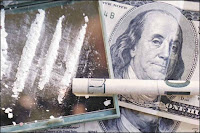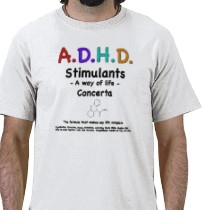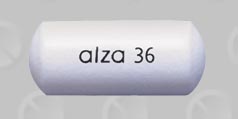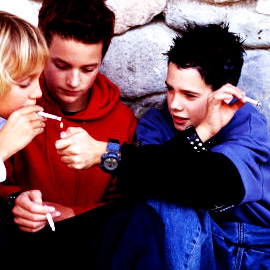 So what’s the big deal about ADD anyway? Why do I care about this “disorder” at all? Why care about a diagnosis that has become so common that the number of children labeled with it has nearly tripled since the 1970s…why? I care because the primary treatment for children branded with ADD is dangerous stimulant drugs.Ritalin, or methylphenidate, was first synthesized in the 1940s and identified as a stimulant the following decade. In the 1960s, doctors first started prescribing Ritalin for hyperactivity, or minimal brain damage, as ADD/ADHD was called then. The 1990s saw an explosion of Ritalin prescriptions, as ADD became the widely diagnosed condition it is today.
So what’s the big deal about ADD anyway? Why do I care about this “disorder” at all? Why care about a diagnosis that has become so common that the number of children labeled with it has nearly tripled since the 1970s…why? I care because the primary treatment for children branded with ADD is dangerous stimulant drugs.Ritalin, or methylphenidate, was first synthesized in the 1940s and identified as a stimulant the following decade. In the 1960s, doctors first started prescribing Ritalin for hyperactivity, or minimal brain damage, as ADD/ADHD was called then. The 1990s saw an explosion of Ritalin prescriptions, as ADD became the widely diagnosed condition it is today.
Ritalin is produced and consumed primarily in the United State, with 85% of all prescriptions going to American kids. Strange that the consuming public has yet to catch on to this anomaly. Hmmm…ADD said to affect 3-5% of kids worldwide, but why is the U.S. the highest consumer of doctor prescribed speed for this disorder??? A newer, time-released version of Ritalin has been on the market for the last decade; it’s called Concerta.
 Ritalin and Concerta work by increasing dopamine levels in the brain. Dopamine is the neurotransmitter responsible for feelings of pleasure and the reward system. The compound methylphenidate is very similar to amphetamines, including methamphetamine (meth, crystal, crank), as they all belong to a family of chemicals called phenethylamines. The all act as central nervous system stimulants. The methylphenidates, however, actually resemble cocaine more in their structure; yet all three substances–cocaine, amphetamines, and Ritalin–all basically do the same thing; they just do it a bit differently, pharmacologically that is.
Ritalin and Concerta work by increasing dopamine levels in the brain. Dopamine is the neurotransmitter responsible for feelings of pleasure and the reward system. The compound methylphenidate is very similar to amphetamines, including methamphetamine (meth, crystal, crank), as they all belong to a family of chemicals called phenethylamines. The all act as central nervous system stimulants. The methylphenidates, however, actually resemble cocaine more in their structure; yet all three substances–cocaine, amphetamines, and Ritalin–all basically do the same thing; they just do it a bit differently, pharmacologically that is.
Like all the other stimulants just noted, Ritalin has a high potential for tolerance and dependency. As tolerance increases, so does the need for greater doses to achieve the same desired effect. The U.S. Drug Enforcement Agency (DEA) knows this, as they pointed out at their 2000 Congressional Testimony before the Committee on Education and the Workforce: Subcommittee on Early childhood, Youth and Families. In response to a 1995 petition by Children and Adults With Attention Deficit Disorder (CH.A.D.D.) and the American Academy of Neurology to lower the regulatory controls on methylphenidate, the DEA conducted an extensive review of the use, abuse liability, actual abuse, diversion, and trafficking of methylphenidate, the DEA said:
The CH.A.D.D. petition characterized methylphenidate as a mild stimulant with little abuse potential – this is not what our review found (emphasis mine) and the petitioners subsequently withdrew their petition. In December 1996, the DEA held a conference on “Stimulant Use in the Treatment of ADHD”. We gathered experts in the fields of ADHD research and treatment, psychiatry, social work, ethics and law enforcement who offered their expertise and unique perspectives to the many controversial topics related to ADHD and its treatment. In addition, the DEA participated in the 1998 National Institutes of Health (NIH) Consensus Conference. In 1998 and 1999, the DEA was invited to the Council of Europe to participate in joint meetings with the Pompidou Group and the International Narcotics Control Board (INCB) to discuss the control of stimulants in Europe and the diagnosis and treatment of ADHD with stimulants. Today, I will present a summary of the data we have gathered about the use of Ritalin and like drugs. These data show:
- The number of children diagnosed as having ADHD is unknown.
- Psychostimulants are effective in treating the symptoms of ADHD. Long-term studies looking at the effects of using these drugs are very limited.
- The medical use of stimulants in the treatment of ADHD in children continues to escalate.
- The expansive use of these drugs for childhood behavioral disorder in the United States differs significantly from medical practices in the rest of the world (United Nations data)
- The NIH Expert Panel (1998 Consensus Conference) concluded that the variability in physician diagnosis of ADHD as evidenced by areas of extremely high and low distribution and prescribing rates of stimulants is suggestive of both over and under-diagnosis (Expert Panel, NIH Consensus Conference).
- Poison control data, emergency room data and high school surveys all indicate that the abuse of methylphenidate has increased significantly since 1990. !!!!
- A number of questionable practices have contributed to the diversion and abuse of stimulant medication including improper diagnosis, lack of adequate information to youth, parents, and schools regarding the abuse potential of these drugs and lax handling of medication (Consensus statement, 1996 DEA Conference).
And in 1997 the United Nation’s International Narcotics Control Board (INCB) has also expressed similar concerns:
- the International Narcotics Control Board (INCB) has observed that world-wide use of methylphenidate has risen from less than 3 tonnes in 1990 to more than 8.5 tonnes in 1994, and continued to rise in 1995.
- The United States accounts for approximately 90 per cent of total world manufacture and consumption of the substance. The unprecedented sharp increase is due to its controversially extensive use in the treatment of ‘attention deficit disorder (ADD)’ in children. Some other countries have also reported more moderate increases in the use of methylphenidate for this purpose.
- The INCB shares the concern of the United States Drug Enforcement Agency (DEA) about the increased use of methylphenidate, most commonly marketed in that country under the brand name Ritalin. The latest data indicates that 10 to 12 per cent of all boys between the ages 6 and 14 in the United States have been diagnosed as having ADD and are being treated with methylphenidate. Treatment is more prevalent in middle class communities and is expected to rise in 1996.
- ADD might be diagnosed too often overlooking other causes for attention and behavior problems and that doctors may be overprescribing methylphenidate. United States investigators found divergent prescribing practices among physicians, only 1 per cent of whom were responsible for the majority of all methylphenidate prescriptions issued. This also has impact on regional variations in the use of methylphenidate.
- The Board is also concerned that, contrary to labeling, some doctors prescribe stimulants to children under the age of six and, in many cases, other recommended forms of treatment are not applied. The duration of treatment with methylphenidate, which in many countries is restricted to three years, tends to be much longer in the United States and many children remain on it into adolescence and even adulthood. No information on possible side-effects of such long-term treatment with methylphenidate is currently available.
- ***The INCB is also concerned that the use of Ritalin is being actively promoted by an influential parent association, which has received significant financial contributions from the preparation’s leading United States manufacturer. The same parent association has petitioned the DEA to ease the control of this substance, a move which would make methylphenidate even more easily available. Among the changes sought is dropping the requirement that the patient be re-examined by a doctor before a prescription for methylphenidate can be refilled.
- At present, the unprecedented high level of ADD diagnosis in children, the very widespread prescription of Ritalin and the growing abuse and black market appear to be limited to the United States. But, the INCB foresees the likelihood that this trend will soon take hold in other countries. Some of the parent groups promoting methylphenidate in the United States have announced their intention to extend their activities outside the country. The Board is therefore requesting all Governments to exercise utmost vigilance to prevent the overdiagnosing of ADD and any medically-unjustified treatment with methylphenidate and other stimulants. It has also requested the World Health Organization (WHO) to investigate this matter and to provide expertise to national public health authorities.
Anybody need more convincing? Ritalin and the other stimulant drugs used to “treat” ADD (Adderall, Concerta, Desoxyn) are habit forming and dangerous (more on this in next post)–the DEA knows it, and so does the United Nations. But today American doctors prescribe these dangerous drugs freely, to treat a condition with such wide parameters and potential for subjectivity (despite what the American Medical Association claims), one that has expanded in its definition steadily since its inception–that’s what really concerns me.
ADD matters to me precisely for these reasons…because if I can help even one family, one child, from getting put on these dangerous drugs, to be treated for something that makes them “different” from the norm (the masses), for something that their teachers can’t figure out or deal with, then I’ll have accomplished something; something I’ll be satisfied with. That’s why I care.
















